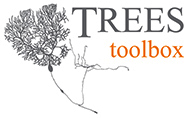
adapted from
PLoS supp. material
by Hermann Cuntz

![]()
The vis_ panel (visualization) controls the one common axis.
To each control panel a prefix is attributed (here „vis_“)
and all computer code related to this control panel uses this prefix
in the core program of the GUI, „cgui_tree“.
A good way to start is to get familiar with the controls of the axis
by keeping one hand on the mouse and one hand on the keyboard.
It is important to practice the axis control using the „vis_“ panel.

The axis is controled by the wheel and the right button of the mouse.
This keeps the left mouse button free for editing.

Keyboard shortcuts are crucial in the process of reconstruction
from image stacks and manual editing of trees.
Here are some keyboard controls for the axis.
The keys [1], [2] and [3] are absolutely crucial to switch
between different view and editing planes.
[q] and [e] control the zoom and [a], [w], [d] and [s] pan the axis.

The 2D views are essential for editing trees and image stacks.
When one of the three 2D views is selected
(by either one of the radio buttons shown on top,
by toggling with the „2D“ control or by using
the [1], [2], [3] or [4] keys) this becomes the editing plane
and all actions are performed accordingly.
For example, manual editing of node positions in a tree
or the manual rotation of an entire tree happen in that plane.

Further axis changes can be made on the secondary view controls:

If the plotted image contains color-coded values
(e.g. the brightness values in an image stack or in this case
the mapping of branch orders on the sample tree),
a colorbar can be summoned up using the colorbar controls.
By default the limits are set automatically.
However, these can be manually adjusted using the two edit fields.

The colormap can be chosen in the menu.
Also, by default, the colormap is transparent but it can be switched back
to opaque in the same menu.
This also affects the image stack representations (but not the trees).

The grid button toggles on/off the grid.
It settles in the plane corresponding to the active view at the coordinate
given by the slicer field.
Grid field coordinates are set according to the two dimensions of the active plane.
The slicer coordinate becomes important later for image stack representation
and manual editing of a tree.



This work is licensed under a
Creative Commons Attribution-Noncommercial-Share Alike 3.0 License